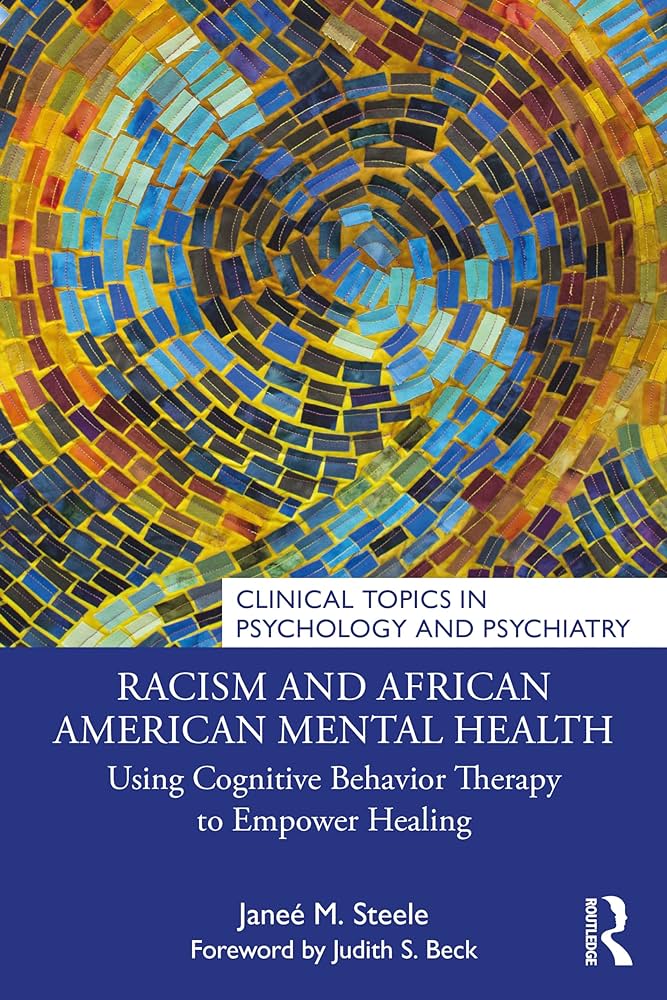Dr. Judith Beck was honored to write the foreword for Racism and African American Mental Health: Using Cognitive Behavior Therapy to Empower Healing by Dr. Janeé M. Steele, now available for pre-order. Read the full foreword below, and pre-order your copy today!
Racism and African American Mental Health: Using Cognitive Behavior Therapy to Empower Healing is a very important book in the evolution of CBT. Janeé Steele has meticulously researched how CBT needs to be adapted for African American clients who have been exposed to racism, often from a very early age. Research shows that repeated encounters with racism are associated with trauma, low self-esteem, clinical depression, and anxiety, and, at its most dangerous, suicidality. African Americans continually experience significant stress and distress related to bias and discrimination in personal, school, or work encounters, either endured or witnessed. Additionally, structural racism has led to many negative social determinants and systemic inequities. African Americans often encounter significant barriers to mental health treatment and receive inadequate care. Fortunately, CBT, appropriately adapted as described so clearly in this thoughtful, pragmatic book, has been shown to be effective in empowering African American clients to overcome these challenges, even when they have internalized anti-Black attitudes and beliefs. Later I will describe some of the conceptual additions and treatment techniques that are essential when working with this population.
But first, to go back in history, my father, Aaron T. Beck, MD, and colleagues conducted the first randomized CBT research study and co-authored the first CBT treatment book (Cognitive Therapy of Depression) in the late 1970s. My father did not know at that time whether CBT would prove to be effective for populations other than the ones he, his colleagues, and his trainees at the University of Pennsylvania were treating. But time has shown that CBT has evolved and its efficacy has been demonstrated for a wide range of psychiatric disorders (even schizophrenia and bipolar disorder), psychological problems, and medical conditions with psychological components. It has been adapted for a wide range of populations: individuals of various ages, cultures, gender identities, and socioeconomic levels. And it is used in a wide variety of settings: schools, residential and vocational programs, medical facilities, correctional settings, community centers, private practice, and others. It is the most highly researched and widely practiced psychotherapy in the world.
It is important to note that from the beginning, Dr. Beck emphasized two foundational principles of CBT. One was that therapists need to conceptualize clients according to a cognitive framework, which posits that the meanings clients put to their experiences are related to their emotional, behavioral, and physiological responses and that the themes in these meanings (that is, their automatic thoughts about situations) are related to their underlying beliefs about themselves, their worlds and other people, and the future. The second foundational principle was that it is essential for therapists to build a strong therapeutic alliance with clients so they will be willing to collaborate with their therapist and engage in the hard work of therapy, both in and out of sessions. Dr. Steele has done an admirable job in describing how to maintain these two core principles and vary their implementation for the African American population by intentionally including social influences and exploration of race (and racism) in case conceptualization and ongoing conversations with clients.

Dr. Steele details how continual exposure to racism and aversive racist experiences, especially the depiction of African Americans as inferior, can cause psychological distress and lead some African American clients to internalize racism. They may see themselves in a negative light; for example, they may believe that they don’t measure up and/or that they are powerless in the face of discrimination. Research indicates that clients may not bring up their concerns about racism in therapy, though. When they don’t, CBT therapists need to initiate these kinds of discussions by directly asking African American clients about their experiences with racism and discrimination and then explore how these kinds of experiences might be related to their specific current difficulties or to obstacles to achieving their aspirations. Failure to do so can decrease the impact of treatment. Failure to do so sensitively can lead to ruptures in the therapeutic relationship and premature termination.
This book is faithful to core conceptual and treatment components of CBT. But crucially, it adds the lens of racism when conceptualizing clients who have experienced racism, enhancing our understanding of why our African American clients often have a strong negative reaction to certain situations, why they may have developed certain coping strategies, why they may be vigilant for harm from others (especially the culturally and politically dominant group), and why they often feel unempowered. It focuses on the importance of adapted psychoeducation, problem-solving, cognitive restructuring, and skills training when clients have experiences of blatant or indirect racism. Equally important is an emphasis on creating opportunities for racial empowerment, including consciousness raising and building racial pride. Transcripts that contrast a traditional CBT approach with a culturally-sensitive CBT approach are wonderful illustrations of how therapists can significantly improve outcomes with African American clients.